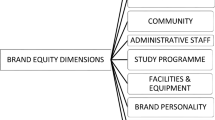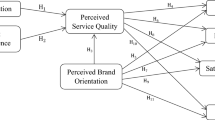Abstract
This study aims to investigate the direction and strength of the relationships among service recovery, relationship quality, and brand image in higher education industries. This research provides a framework for school managers to understand service recovery from an operations perspective. Structural equation models were used to test the proposed relationships: relationships linking relationship quality, service recovery, and brand image in higher education industries. The data source is a survey of undergraduate students at universities in Taiwan. The total sample was composed of 600 surveyed students from 12 universities. Of this total, 550 students answered the questionnaire, 526 of whom answered all of the study questions. These figures represent a success rate of more than 80 %. From these results, the following three research hypotheses were tested: (H1) Service recovery is positively associated with relationship quality; (H2) Service recovery is positively associated with brand image; and (H3) Relationship quality is positively associated with brand image. Viewing schools as having service recovery and relationship quality affected the brand image of students. Based on these results, schools managers can address service recovery and relationship quality to achieve a good school brand image. In addition, the author presents numerous relevant directions for future research and highlights the findings’ implications for research and practice. Finally, the author discusses the study’s limitations.

Similar content being viewed by others
References
Alam, G. M., & Khalifa, M. T. B. (2009). The impact of introducing a business marketing approach to education: A study on private HE in Bangladesh. African Journal of Business Management, 3(9), 463–474.
Ana, R. L., Rodolfo, V. C., & Ana, D. M. (2009). Satisfaction with service recovery: Perceived justice and emotional responses. Journal of Business Research, 62, 775–781.
Bagozzi, R. P., & Yi, Y. (1988). On the evaluation of structure equation models. Journal of the Academy of Marketing Science, 16, 74–94.
Baker, J. A. (1999). Teacher-student interaction in urban at-risk classrooms: Differential behavior, relationship quality, and student satisfaction with school. The Elementary School Journal, 100(1), 57–70.
Ballantyne, R., Warren, A., & Nobbs, K. (2006). The evolution of brand choice. Journal of Brand Management, 13, 339–352.
Basheer, A. M. (2008). The impact of marketing actions on telationship quality in the higher education sector in Jordan. Journal of Marketing for Higher Education, 16(2), 1–23.
Bejou, D., & Palmer, A. (1998). Service failure and loyalty: An exploratory empirical study of airline customer. The Journal of Services Marketing, 12(1), 7–22.
Bell, C.R., & Zemke, R.E. (1987). Service breakdown: The road to recovery. Management Review, 76(10), 32–35.
Bentler, P. M. (1990). Comparative fit indexes in structural models. Psychological Bulletin, 107(2), 238–246.
Bitner, M. J., Booms, B. H., & Tetreault, M. S. (1990). The service encounter: Diagnosing favorable and unfavorable incidents. Jourtial of Marketirrg, 54, 71–84.
Boshoff, C. (2005). A re-assessment and refinement of RECOVST. Managing Service Quality, 15, 410–425.
Browne, M. W., & Cudek, R. (1993). Alternative ways of assessing model fit. In K. A. Bollen & J. S. Long (Eds.), Testing structural equation models. Riverside County: Sage.
Chang, C. C. (2008). Choice, perceived control, and customer satisfaction: The psychology of online service recovery. CyberPsychology & Behavior, 11(3), 321–328.
Chang, Y. W., & Chang, Y. H. (2010). Does service recovery affect satisfaction and customer loyalty? An empirical study of airline services. Journal of Air Transport Management, 16, 340–342.
Chang, D. S., & Wang, T. H. (2012). Consumer preferences for service recovery options after delivery delay when shopping online. Social Behavior & Personality, 40(6), 1033–1044.
Chen, Y. S. (2009). The drivers of green brand equity: Green brand image, green satisfaction and green trust. Journal of Business Ethics, 93, 307–319.
Chen, M., Zhou, J., & Li, T. (2008). The impact of service quality and relationship quality on E-shop brand image. In IEEE International Conference on service operations and logistics, and informatics, 2008 (IEEE/SOLI 2008), (pp. 89–92).
Cheng, Y. H. (2012). The effect of brand recognition on service recovery. European Journal of Business and Social Sciences, 1(6), 52–60.
Craighead, C., Karwan, K., & Miller, J. (2004). The effects of severity of failure and customer loyalty on service recovery strategies. Production and Operations Management, 13(4), 307–321.
Cretu, A. E., & Brodie, R. J. (2007). The influence of brand image and company reputation where manufacturers market to small firms: A customer value perspective. Industrial Marketing Management, 36(2), 230–240.
Crosby, L., Evans, K., & Cowles, D. (1990). Relationship quality in services selling: An interpersonal influence perspective. Journal of Marketing, 54(3), 68–81.
Curran, J. M., & Rosen, D. E. (2006). Student attitudes toward college courses: An examination of influences and intentions. Journal of Marketing Education, 28(2), 135–148.
Czarniawska, B., & Genell, K. (2002). Gone shopping? Universities on their way to market. Scandinavian Journal of Management, 18(4), 455–474.
Dong, B., Evans, K., & Zou, S. (2008). The effects ofcustomer participation in co-created service recovery. Journal of the Academy of Marketing Science, 36(1), 123–137.
Dos Santos, C. P., & Fernandes, D. (2007). The impact of service recovery processes on consumer trust and loyalty in Car Repair Services. Latin American Business Revie, 8(2), 89–113.
Eric, J. A. (2008). Selling higher education: Marketing and advertising America’s colleges and universities. Hoboken: Wiley.
Fornell, C., & Larcker, D. F. (1981). Evaluating structural equation models with unobservable and measurement errors. Journal of Marketing Research, 18(1), 39–50.
Fornell, C., & Wernerfelt, B. (1987). Defensive marketing strategy by customer complaint management: A theoretical analysis. Journal of Marketing Research, 24, 337–346.
Garbarino, E., & Johnson, M. S. (1999). The different roles of satisfaction, trust, and commitment in customer relationships. Journal of Marketing, 63(April), 70–87.
Gronroos, C. (1988). Service quality: The six criteria of good perceived service quality. Review of Business, 9, 10–13.
Gruber, T., Chowdhury, I. N., & Reppel, A. E. (2011). Service recovery in higher education: Does national culture play a role? Journal of Marketing Management, 27(11–12), 1261–1293.
Hair, F. J., Anderson, R., Ronald, L., Tatham, R. T., & Black, W. C. (1998). Multivariate data analysis. Upper Saddle River: Prentice Gall.
Hair, J. F., Black, W. C., Bahin, B. J., Aderson, R. E., & Tatham, R. L. (2006). Multivariate data analysis (6th ed.). Upper Saddle River: Pearson Prentice Hall.
Halim, L., Meerah, S. M., Zakaria, E., Abdullah, S. I. S. S., & Tambychik, T. (2012). An exploratory factor analysis in developing pedagogical content knowledge scale for teaching science. Research Journal of Applied Sciences, Engineering and Technology, 4(19), 3558–3564.
Iyer, R., & Muncy, J. A. (2008). Service recovery in marketing education: It’s what we do that counts. Journal of Marketing Education, 30(1), 21–32.
Johnston, R. (1995). Service failure and recovery: Impact, attributes and process. Advances in Services Marketing and Management, 4, 211–228.
Keating, B. W., Kriz, A., Alpert, F., & Quazi, A. (2011). Mediating role of relationship quality in online services. Journal of Computer Information Systems, 52(2), 33–41.
Keller, K. L. (1993). Conceptualizing, measuring, and managing customer-based brand equity. Journal of Marketing, 57(1), 1–22.
Kim, H. B., & Kim, W. G. (2005). The relationship between brand equity and firms’ performance in luxury hotels and chain restaurants. Tourism Management, 26, 549–560.
Kotler, P. (2001). A framework for marketing management. Upper Saddle River: Prentice-Hall.
Kuenzel, S., & Katsaris, N. (2009). A critical analysis of service recovery processes in the hotel industry. TMC Academic Journal, 4(1), 14–24.
Liao, S., & Cheng, C. C. (2013). Consumer evaluation of self-service innovation failure: The effect of brand equity and attribution. The Service Industries Journal, 33(5), 467–485.
Linder, C., & Seidenstricker, S. (2010). The strategic meaning of ingredient brands: A resource-based analysis. Asian Journal of Marketing, 4, 1–16.
Magid, J. M., Cox, A. D., & Cox, D. S. (2006). Quantifying brand image: Empirical evidence of trademark dilution. American Business Law Journal, 43, 1–42.
Maringe, F., & Gibbs, P. (2009). Marketing higher education: Theory and practice. New York: McGraw-Hill.
Mark, A. K. (2011). Business practices in higher education: A guide for today’s administrators. New York: Routledge.
Mattila, A. (2001). The effectiveness of service recovery in multi-industry setting. Journal of Services Marketing, 16(6/7), 583–596.
Meyers, L. S., Gamst, G., & Guarino, A. J. (2006). Applied multivariate research: Design and interpretation. Thousand Oaks: Sage.
Miller, J. L., Craighead, C. W., & Karwan, K. R. (2000). Service recovery: A framework and empirical investigation. Journal of Operations Management, 18, 387–400.
Mount, D. (2012). Putting the dollar signs on quality: The benefits of service recovery in the hotel industry. Journal of Quality Assurance in Hospitality & Tourism, 13(2), 152–163.
Nikbin, D., Ismail, I., Marimuthu, M., & Jalalkamali, M. (2010). Perceived justice in service recovery and recovery satisfaction: The moderating role of corporate image. International Journal of Marketing Studies, 2(2), 47–56.
Park, C. W., Jaworski, B. J., & Maclnnis, D. J. (1986). Strategic brand concept: Image management. Journal of marketing, 50(4), 135–145.
Schumacker, R. E., & Lomax, R. G. (2004). A beginner’s guide to structural equation modeling. Mahwah: Lawrence Erlbaum.
Seawright, K. K., DeTienne, K. B., Bernhisel, M. P., & Larson, C. L. H. (2008). An empirical examination of service recovery design. Marketing Intelligence & Planning, 26(3), 253–274.
Sharma, S. (2012). Influence of culture on service recovery expectations. Indian Streams Research Journal, 2(9), 1–11.
Sheth, J. N., & Parvatiyar, S. (1995). The evolution of relationship marketing. International Business Review, 4(4), 397–418.
Smith, J. B. (1998). Buyer-seller relationships: Similarity, relationship management, and quality. Psychology & Marketing, 15(January), 3–21.
Smith, A. K., Bolton, R. N., & Wagner, J. (1999). A model of customer satisfaction with service encounters involving failure and recovery. Journal of Marketing Research, 36(August), 356–372.
Spreng, R. A., Harrell, G. D., & Mackoy, R. D. (1995). Service recovery: Impact on satisfaction and intentions. Journal of Service Marketing, 9, 15–23.
Thorsten, H. T., Gwinner, K. P., & Gremler, D. D. (2002). Understanding relationship marketing outcomes: An integration of relational benefits and relationship quality. Journal of Service Research, 4(3), 230–247.
Toma, J.D., Dubrow, G., & Hartley, M. (2005). The uses of institutional culture: Strengthening identification and building brand equity in higher education. ASHE Higher education Report 31, No. 2. In Kezar, A. J., Ward, K., and Wolf-Wendel, L., (Series Eds). Wiley Periodicals Inc., San Francisco, CA: Jossey-BAss.
Wong, S. I. (2012). Service recovery in the higher education: A case study of Malaysia. Saarbrücken: LAP LAMBERT Academic Publishing.
Zakarial, Z., Roslin, R. M., & Daud, N. M. (2011). The influence of market orientation on the commitment, trust and relational norms in the education context. African Journal of Business Management, 5(22), 8875–8890.
Zemke, R., & Bell, C. R. (1990). Service recovery: Doing it right the second time. Training, 27(6), 42–48.
Author information
Authors and Affiliations
Corresponding author
Rights and permissions
About this article
Cite this article
Chen, YC. A Study of the Interrelationships Among Service Recovery, Relationship Quality, and Brand Image in Higher Education Industries. Asia-Pacific Edu Res 24, 81–89 (2015). https://doi.org/10.1007/s40299-013-0160-3
Published:
Issue Date:
DOI: https://doi.org/10.1007/s40299-013-0160-3




